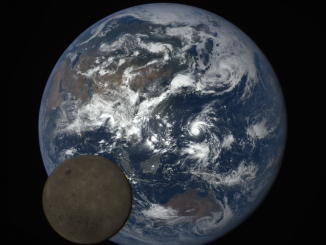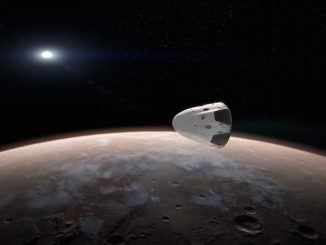
The Curiosity rover’s next destination is a moving mound of wind-blown dark sand blanketing the base of Mount Sharp, the focal point of the Mars mission’s research, scientists said this week.
It will take a few days to reach the dunes, and rover drivers at NASA’s Jet Propulsion Laboratory must be careful to avoid guiding Curiosity too far into the dune field and getting stuck.
A similar predicament ended the mission of the Spirit rover, Curiosity’s predecessor on the red planet, when it drove into a much smaller sand trap in 2009. Engineers were never able to free the rover from the sand pit, and the craft’s solar panels were pointed in the wrong direction to collect energy from the sun as it fell low on the horizon in the Martian winter.
Curiosity will not have the same pitfall as Spirit because it relies on a nuclear power source, but an entangled rover would threaten the future of the mission, which is in its fourth year.
Curiosity will be the first rover to explore an active Martian sand dune up close. The rover is heading for a stretch of sand dunes called the “Bagnold Dunes” named for Ralph Bagnold, a British military engineer who pioneered research into how winds transport sand grains in the early 20th century.
One of the dunes is as tall as a two-story building and as broad as a football field, according to a NASA press release.
Images from a sharp-eyed camera aboard NASA’s Mars Reconnaissance Orbiter show the dunes are moving up to 3 feet, or 1 meter, per year, scientists said.
As of Monday, Curiosity was about 200 meters, or 660 feet, from the dune it is heading to first. The rover has completed further drives this week.
“The Bagnold Dunes are tantalizingly close, and this week is mostly focused on driving to the dunes. On Sol 1167 (overnight Tuesday, U.S. time), Curiosity drove 39 meters (128 feet), and the dunes are starting to look pretty big,” wrote Lauren Edgar, a research geologist with the U.S. Geological Survey and a member of the Curiosity science team, in a blog post Wednesday.
Once Curiosity reaches the dunes, scientists plan to use the rover’s robot arm to scoop a sample of sand for delivery to the craft’s internal laboratory instruments. The rover will also use a wheel to dig into the dune to reveal its interior, according to NASA.
Curiosity is slowly trekking up the foothills of Mount Sharp, a three-mile-high peak inside Gale Crater, a basin excavated by an asteroid or comet impact.

The dune campaign is a natural extension of Curiosity’s primary focus of studying ancient geological processes that shaped rocks and made the red planet habitable billions of years ago, scientists said.
“We’ve planned investigations that will not only tell us about modern dune activity on Mars but will also help us interpret the composition of sandstone layers made from dunes that turned into rock long ago,” said Bethany Ehlmann, a scientist at the California Institute of Technology and JPL.
The water flows and volcanism that carved giant channels and built towering mountains on Mars in ancient times are no more. Winds are now the most significant cause of Martian erosion, scientists said.
Wind measurements to prepare for the dune campaign have already begun. Geologists hope to learn how much of a role wind played in forming ancient sedimentary rocks like sandstone compared to the effects of water in transporting sediments.
“We will use Curiosity to learn whether the wind is actually sorting the minerals in the dunes by how the wind transports particles of different grain size,” Ehlmann said in a NASA press release.
Researchers believe dunes on Mars behave differently than they do on Earth. The surface pressure on Mars is about six-tenths of one percent the pressure on Earth, with Martian gravity three times weaker than Earth’s.
“These dunes have a different texture from dunes on Earth,” said Nathan Bridges from the Johns Hopkins University’s Applied Physics Laboratory, who leads dune campaign planning with Ehlmann. “The ripples on them are much larger than ripples on top of dunes on Earth, and we don’t know why. We have models based on the lower air pressure. It takes a higher wind speed to get a particle moving. But now we’ll have the first opportunity to make detailed observations.”
Email the author.
Follow Stephen Clark on Twitter: @StephenClark1.



